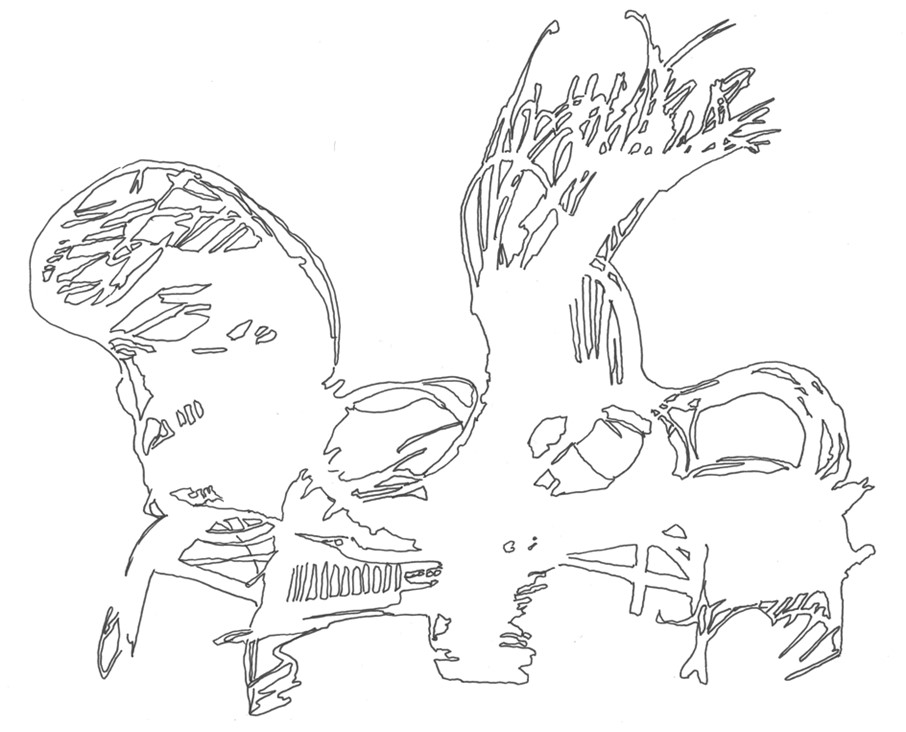To Research by Two Hands
DOI:
https://doi.org/10.7577/information.5068Keywords:
artistic research, drawing, writingAbstract
In this article, we explore artistic research methods by committing ourselves to writing in a sense Cixous is thematizing in her book Three Steps to the Ladder of Writing: a way of writing that includes what is banished, considered unclean, the mute and the missing, and by including drawing in the attempt.
Our article’s starting point is our experiences working with and producing conventional and publishable academic texts. Our experiences have, in ways that still are not transparent to us, made the transition towards achieving the right skills for producing orthodox academic texts more complicated and hurtful than we could imagine. The desired language, the academic, is a language created to represent reality in transparent ways; you are expected to be able to present the world as a series of findings. Our writing and drawing as creations are contrary to this reduction.
The text and the drawings attempt to demonstrate and discuss the possibilities of engaging in writing and drawing as production on its own terms and stop regarding them as activities that mirror what already is. Instead, we aim to experiment and thus maybe create something that was not already there, something new, something that might be missing.
References
Bennett, J. (2010). Vibrant Matter: A Political Ecology of Things. Duke University Press. https://books.google.no/books?id=Vok4FxXvZioC
Brice, S. (2018). Situating skill: Contemporary observational drawing as a spatial method in geographical research. Cultural Geographies, 25(1), 135–158. https://doi.org/10.1177/1474474017702513
Cixous, H. (1993) Three Steps on the Ladder of writing. Columbia University Press
Deleuze, G. (1992) Postscript on the Societies of Control. October, Vol. 59 (Winter 1992), 3-7.
Fels, L. (2012). Collecting Data Through Performative Inquiry: A Tug on the Sleeve. Youth Theatre Journal, 26(1), 50–60. https://doi.org/10.1080/08929092.2012.678209
Haraway, D. (2000) How like a leaf: An interview with Thyrza Nichols Goodeve / Donna Haraway. Routledge.
Hendrickson, C. (2008). Visual Field Notes: Drawing Insights in the Yucatan. Visual Anthropology Review, 24(2), 117–132. https://doi.org/10.1111/j.1548-7458.2008.00009.x
Irwin, R. L. (2013). Becoming A/r/tography. Studies in Art Education, 54(3), 198–215. https://doi.org/10.1080/00393541.2013.11518894
Kaihovirta-Rosvik, H. (2009). Images of imagination: An aesthetic approach to education.
Lie, S. (2005). Life Makes Text from My Body: A Reading of Hélène Cixous’ La Venue à l’écriture. In B. Regina & A. J. Lee (eds.), Hélène Cixous: Critical Impressions (Vol. 1, pp. 1–22). Taylor and Francis. https://doi.org/10.4324/9780203990339
McGuirk, T. (31 May 2013–1 June 2013). Drawing as situated knowing. Drawing in the University Today. University of Porto.
Pallasmaa, J. (2012). The eyes of the skin: Architecture and the senses (3rd ed.) Wiley.
Parr, A. (2010). The Deleuze dictionary (Rev. ed.). Edinburgh University Press. https://doi.org/10.1515/9780748643271
Schmidgen, H. (2015). Cerebral Drawings between Art and Science: On Gilles Deleuze’s Philosophy of Concepts. Theory, Culture & Society, 32(7-8), 123–149. https://doi.org/10.1177/0263276415616681
Sjøvoll, V., Grothen, G., & Frers, L. (2020). Abandoned ideas and the energies of failure. Emotion, Space and Society, 36, Article 100709. https://doi.org/10.1016/j.emospa.2020.100709
Taussig, M. (2011). I Swear I Saw This: Drawings in Fieldwork Notebooks, Namely My Own. University of Chicago Press. https://books.google.no/books?id=-ZM9r839lP8C

Downloads
Published
How to Cite
Issue
Section
License
Copyright (c) 2022 Vibeke Sjøvoll, Geir Grothen

This work is licensed under a Creative Commons Attribution 4.0 International License.
Authors who publish with this journal agree to the following terms:
- Authors retain copyright and grant the journal right of first publication with the work simultaneously licensed under a Creative Commons Attribution License that allows others to share the work with an acknowledgement of the work's authorship and initial publication in this journal.
- Authors are able to enter into separate, additional contractual arrangements for the non-exclusive distribution of the journal's published version of the work (e.g., post it to an institutional repository or publish it in a book), with an acknowledgement of its initial publication in this journal.
- Authors are permitted and encouraged to post their work online (e.g., in institutional repositories or on their website) prior to and during the submission process, as it can lead to productive exchanges, as well as earlier and greater citation of published work (See The Effect of Open Access).